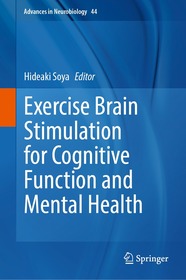
Exercise Brain Stimulation for Cognitive Function and Mental Health
Series: Advances in Neurobiology; 44;
- Publisher's listprice EUR 213.99
-
88 752 Ft (84 526 Ft + 5% VAT)
The price is estimated because at the time of ordering we do not know what conversion rates will apply to HUF / product currency when the book arrives. In case HUF is weaker, the price increases slightly, in case HUF is stronger, the price goes lower slightly.
- Discount 20% (cc. 17 750 Ft off)
- Discounted price 71 002 Ft (67 621 Ft + 5% VAT)
Subcribe now and take benefit of a favourable price.
Subscribe
88 752 Ft

Availability
printed on demand
Why don't you give exact delivery time?
Delivery time is estimated on our previous experiences. We give estimations only, because we order from outside Hungary, and the delivery time mainly depends on how quickly the publisher supplies the book. Faster or slower deliveries both happen, but we do our best to supply as quickly as possible.
Product details:
- Publisher Springer Nature Singapore
- Date of Publication 27 September 2025
- Number of Volumes 1 pieces, Book
- ISBN 9789819500659
- Binding Hardback
- No. of pages433 pages
- Size 235x155 mm
- Language English
- Illustrations XV, 433 p. 70 illus., 54 illus. in color. Illustrations, black & white 699
Categories
Long description:
This book provides compelling evidence on the beneficial effects of aerobic exercise on the brain, focusing on the prefrontal cortex and hippocampus, which are crucial for cognitive and memory functions. Organized into three major themes, it offers a comprehensive exploration of translational research from animals to humans, the interaction between the brain and peripheral organs, and advanced methodologies for understanding exercise's impact on brain health. These themes collectively offer a systematic exploration of exercise's impact on brain health, integrating the latest scientific insights from both animal and human studies.
The chapters delve into key concepts such as the role of myokines and hepatokines in mediating exercise's effects on the brain, the neuroprotective potential of physical activity, and its application as a therapeutic intervention for neuropsychiatric conditions like Alzheimer's disease and depression. By bridging basic and applied knowledge, this book provides a cohesive framework for understanding how exercise influences brain structure, function, and neurochemical pathways. It also introduces novel methodologies and modulatory factors that may enhance or contextualize these effects, offering a critical synthesis of a rapidly evolving field.
This volume is an invaluable resource for researchers, clinicians, educators, and students in neuroscience, physiology, and psychiatry. It serves as both a reference and a catalyst for further research and practical applications, encouraging a shift in how we conceptualize exercise: not merely as a component of good health, but as a dynamic modulator of brain function. By providing a detailed understanding of the mechanisms underlying exercise's effects on the brain, this book invites readers to explore the potential of physical activity as a non-pharmacological tool for supporting cognitive and emotional well-being.
MoreTable of Contents:
Chapter 1. Treadmill Running Model for Rodents as a Translational Approach Based on Human Physiological Responses.- Chapter 2. Neuronal Activity in Rat Hippocampus during Mild Treadmill Running.- Chapter 3. Hippocampal Neurogenesis Via Light Running and its Mechanism.- Chapter 4. Minimum Exercise Model in Humans based on VO2peak and Physiological Parameters.- Chapter 5. Exercise benefits on human dentate gyrus function assessed by mnemonic discrimination and high-resolution fMRI: bridging from animal models of exercise hormesis.- Chapter 6. Pupil dynamics predict exercise brain stimulation: An overview of exercise pupillometry.- Chapter 7. Physical Exercise Benefits Cognition: A Narrative Review of Evidence and Possible Mechanisms.- Chapter 8. Potential role of extracellular vesicles in mediating effects of exercise on brain function.- Chapter 9. Acute Exercise Effects on Executive Function: Exploring the Relationship and Moderating Factors Through the 3W+1H Framework.- Chapter 10. Involvement of dopamine in cognitive improvement by aerobic exercise.- Chapter 11. The Dual Role of Lactate in the Exercising Brain: Fueling Energy and Signaling Fatigue.- Chapter 12. Interoceptive Signaling by Circulating Insulin Like Growth Factor I and Neuroprotection by Exercise.- Chapter 13. Exploring the Impact of High-Intensity Interval Training on Cognitive Functions - Muscle and Brain interaction.- Chapter 14. Assessing Exercise and Fitness-Related Brain Health Using Multi-Modal Magnetic Resonance Imaging Outcomes.- Chapter 15. The Effects of Exercise on Hippocampus-based Cognitive Dysfunction in Type 2 Diabetes Mellitus: A Possible involvement of Hippocampal Monocarboxylate Transporter 2.- Chapter 16. Exercise as a therapeutic intervention for Alzheimer's disease.- Chapter 17. Neuroprotective and Neurotrophic Effects of Astaxanthin on the Brain.- Chapter 18. HIT your Brain: Neuron & New Run.- Chapter 19. Enriched exercise environment boosting exercise effects on the brain: Beneficial effects of music.- Chapter 20. Application of Minimum Exercise Model to the Hypoxia Environment.- Chapter 21. Healthy Cognitive Aging through Movement: A Practical Approach of Light-Intensity Aerobic Dance for Older Adults.- Chapter 22. Gating of neuroplasticity: Effects and Mechanisms of Acute Aerobic Exercise as a Brain Stimulation for the Sensorimotor Cortex.
More



